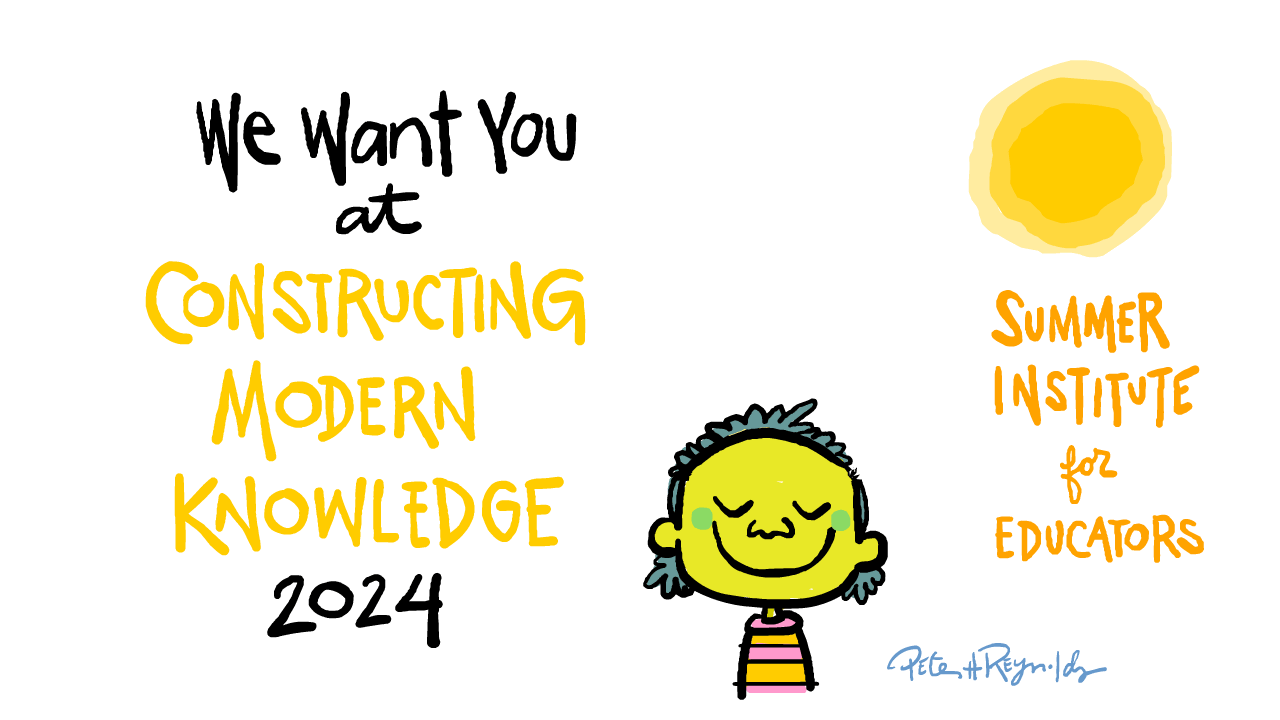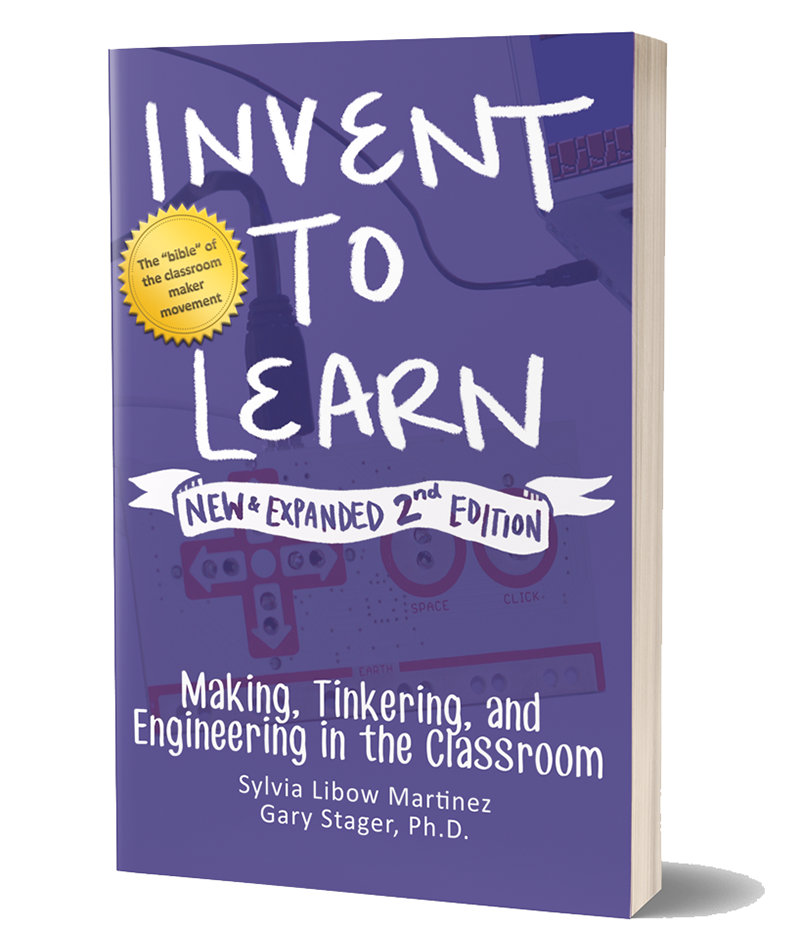Our book, Invent to Learn: Making, Tinkering, and Engineering in the Classroom is being translated into Lithuanian. Ahead of the Fall release, I asked if I could contribute a foreword for what will be the 10th language edition of our book. In the following foreword, I share a few reflections and challenges.
“There ain’t no rules around here, we’re trying to accomplish something.”
– Thomas A. Edison
“We’re making sandwiches over here!” – Fat Sal’s (a Los Angeles sandwich shop)
Dear Reader,
It is a great honor to welcome you to the tenth translation of Invent to Learn: Making, Tinkering, and Engineering . Sylvia and I are thrilled that our book will finally be enjoyed by Lithuanian educators. I have great affection for your country. I have enjoyed three trips to your land. Not only am I captivated by its beauty and the spirit of its citizens, but I have Lithuanian roots.
My maternal grandmother, Lillian Fink (née Liechenstein), was born in Villnius in 1907. Her parents, a tailor, Michael Liechenstein and her mother, Annie (Chaya) Resnick, a dressmaker, both lived in Vilnius. In 1908, Annie took her two young children, Benjamin, age 4, and Lillian, age 1, from the Port of Bremen to Ellis Island in the United States, aboard the SS Prinz Friedrich Wilhelm to join her husband who had already settled in New Jersey, where I was born. I knew my great grandmother Annie and grandmother Lillian when I was a child.
Sylvia and I are gratified by how well Invent to Learn has been received by educators around the world. Our decision to focus on powerful ideas, the capacity of children, and the competence of creative educators has lent the book a timeless quality. It avoids fads, gimmicks, rubrics, exams, and competition in the educational context. Invent to Learn acknowledges a rapidly changing world while embracing the progress leading to a more just, creative, and joyful world for the children we serve.
I wish to share a few observations and concerns that have emerged since we originally wrote this book. The renewed interest in learning-by-making, often referred to as “the maker movement,” gave us the ability to make things with bits and atoms. Sadly, however, the bits have been left behind. Lots of eager teachers and excited students are cutting up a lot of cardboard and making physical stuff but have failed to take advantage of the gifts afforded by computing. Computation allows one to add interactivity and intelligence to everyday things. It is the secret sauce or superpower of learning by making. For too long, children have been deprived of agency over an increasingly complex and technologically sophisticated world, by not being taught computer programming or to use the remarkably powerful computational software environments now available.
Making without computation is arts and crafts. There is nothing wrong with arts and crafts, but we should be honest about our actions. We must ask why such creative pursuits are not found in more school subjects. The school technology teacher or makerspace educator should not be the only person nurturing creativity or making connections between disciplines.
Our stance, now more than ever, is pro-computation. The great mathematician and scientist, Dr. Stephen Wolfram says, that “computation is the paradigm for today’s world,” and that a rewarding life requires “organizing your thoughts clearly enough that you can explain them to a sufficiently smart computer.” These ideals are wholly consistent with our pedagogical father, Dr. Seymour Papert, and the progressive educators we celebrate in these pages.
Computation is a rich context for constructionism and constructionism is a bulwark against fascism. Forces of darkness disguised as “science of learning” or “explicit direct instruction,” represent forms of pedagogical authoritarianism, reinforce the fallacious notion that learning is the result of having been taught, and convey a dangerous belief that there is one way to learn something.
At a time of rising authoritarianism, fake news, algorithmic manipulation, information warfare, and a narrowing view of humanity, constructionism situates the learner at the center of the universe and reminds us of the fragility of democracy. There is no better way to understand how complex systems work, than to create, manipulate, and transform them for your own purposes.
These are not new ideas. They are resonant in the work of the educators of Reggio Emilia, found in Seymour Papert’s writings, and embraced by philosophers such as McLuhan, Postman, Illitch, and Friere. They are also consistent with the early goals of the MIT Artificial Intelligence Laboratory of the 1960s and 70s, where the programming language, Logo, was created and the goal was “computational making” with the computer as “the children’s machine.”
“To understand is to invent”
– Jean Piaget
Speaking of AI… As a world of adults lose their collective minds over the availability of generative artificial intelligence tools like ChatGPT, Claude, and Gemini, it is worth thinking of them in terms of what you (or your students) might be able to make or make better because of such technological wonders. Our colleague Ken Kahn’s recent book, The Learner’s Apprentice: AI and the Amplification of Human Creativity, is in the spirit of Invent to Learn. It is my sincere hope that readers of this book will go beyond the chatbots, which are so good at answering questions, and explore software environments like Wolfram Language with its new AI-powered Notebook Assistant. Such computational making environments allow children to be mathematicians and scientists, rather than being taught math or science. It allows them explore ideas and make contributions on the frontiers of knowledge. So much is possible that it would be a sin to waste these opportunities.
Seymour Papert reminds us that if you make simple things easy to do, you make complexity possible. The computer and computational materials increase the range of colors in the crayon box and expand the breadth and depth of possible projects. My hope is that the availability of tools and ideas shared in this book will lead to a heightened and expanded view of what children can do or make. Such progress should be demonstrable. My personal “standard” is that for any project I propose for students, 10% will do something interesting and 5% will make or do something I never imagined.
This new standard ensures that teaching remains stimulating and keeps pace with technological progress.
I find the school makerspace to be both a terrible idea and a miracle. It is a terrible idea because I want making to permeate every corner of the school every moment of the school day. We believe making is among the most effective ways to learn. However, the makerspace restricts such purposeful knowledge construction to a ghetto visited once a week or two. Of course, some hardware is expensive, dangerous, or needs to be secured, but those reasons fail to justify the novelty of making being restricted to a specific place at a particular time. The act and spirit of learning-by-making should be everywhere.
That said, the school makerspace is also a miracle. As makerspaces and Fab Labs approach twenty years old, it is remarkable that communities still value and invest in them. This is much longer than the typical lifespan of most education initiatives that last a mere five or so years. I will leave it to you as you read this book to think about why “making” remains so appealing to so many constituent groups.
If the makerspace is the sole source of playful, fun, childlike, modern, deep, and computationally-rich learning in a school—so be it. At least your school acknowledges and respects the rights, capacity, and creativity of children in small doses. Regardless of the context in which making exists in your school, we must maintain a sense of urgency. Our children, teachers and planet deserve no less. Your students do not need a fieldtrip to Užupis, your school needs to be Užupis. Utopia is a worthy ideal.
The great American author and civil rights activist, Jonathan Kozol reminds us that “you’re only 7 once.” This book is nearly 13 years-old, so you may have some catching up to do, but if I know anything about Lithuanians, it is that you are up to the task.
Thanks for making the world a better place for children!
Gary S. Stager, PhD
July 2025
Veteran educator Gary Stager, Ph.D. is the author of Twenty Things to Do with a Computer – Forward 50, co-author of Invent To Learn — Making, Tinkering, and Engineering in the Classroom, publisher at Constructing Modern Knowledge Press, and the founder of the Constructing Modern Knowledge summer institute. He led professional development in the world’s first 1:1 laptop schools thirty years ago and designed one of the oldest online graduate school programs. Gary is also the curator of The Seymour Papert archives at DailyPapert.com. Learn more about Gary here.


